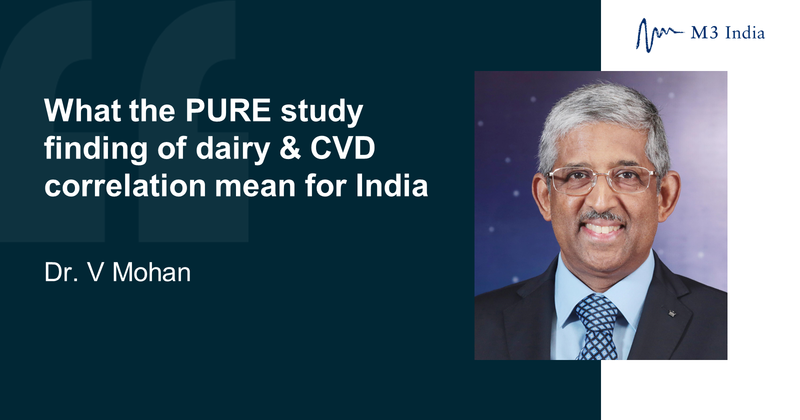What the PURE study finding of dairy & CVD correlation mean for India: Dr. V Mohan
M3 India Newsdesk Sep 30, 2018
In part 2 of the World Heart Day series, Padma Shri Dr. V Mohan, an eminent Diabetologist, and one of the lead investigators on PURE study provides his commentary on a chief finding- correlation between dairy intake and CVD, and what this means for India.

I am privileged to have been part of the Prospective Urban and Rural Epidemiological (PURE) study group which published this article on dairy in ‘The Lancet’.
The study clearly shows that dairy intake is not only ‘not harmful’ as it was popularly believed in the past but its use was in fact associated with a lower risk of mortality and major cardiovascular disease events. This was seen in multiple populations and countries.
The PURE study involved 1,36,384 individuals from 21 countries in 5 continents. We studied both whole fat and dairy fat and the primary outcome was composite mortality or major cardiovascular events defined as death from cardiovascular disease, non-fatal myocardial infarction, stroke, or heart failure.
We showed that higher intake of total dairy (more than two servings per day) was associated with lower risk of the composite outcome, total mortality, non-cardiovascular mortality, cardiovascular mortality, major cardiovascular disease, and stroke. There was no statistically significant association seen with myocardial infarction (MI) although the results were beneficial in MI also.
Further sub-analysis of the types of dairy used showed that higher intake of milk and yoghurt was associated with a lower risk of composite outcomes, whereas cheese was not, and clinically having a neutral effect. The intake of butter was low, but with butter, the hazards ratio was greater than 1, although this was not statistically significant.
How do these findings relate to India?
In India, the overall dairy intake is low except for milk and yoghurt. Obviously, milk and yoghurt have come out beneficial in the study, so that’s a good thing for Indians. The intake of cheese is not very high in India and since it has an absolutely neutral effect, cheese intake can be encouraged, particularly since it is quite ‘filling’ and can help to cut down the carbohydrate intake which is the main culprit in Indians, as far as both diabetes and cardiovascular disease are concerned.
As far as butter and ghee are concerned, our results from the ICMR-INDIAB study show that in Punjab where the intake of butter and ghee is high, the serum cholesterol level and the LDL cholesterol level are the highest and obesity rates were also the highest. Hence, it is better for us to be careful with the intake of butter and ghee in our country. Small quantities obviously will not matter, but we have to be careful about consuming large quantities of butter and ghee.
Overall, the results of this study are encouraging because dairy has a lot of beneficial effects. It has been shown that dairy products can beneficially influence various biological pathways such as the angiotensin converting enzymes, osteocalcin, and gut microbiome interactions such as intestinal integrity and endotoxemia.
Obviously, more studies need to be done to find out the beneficial effects of dairy. The overall message from this paper is that we should encourage people in India to increase the dairy intake.
In Part 1 of the series,Dr. JPS Sawhney, a pioneer in Clinical & Preventive Cardiology, provides his take on diet & CVD. Read Diet and CVD correlation for India: Dr. JPS Sawhney
Disclaimer- The views and opinions expressed in this article are those of the author's and do not necessarily reflect the official policy or position of M3 India.
-
Exclusive Write-ups & Webinars by KOLs
-
Daily Quiz by specialty
-
Paid Market Research Surveys
-
Case discussions, News & Journals' summaries